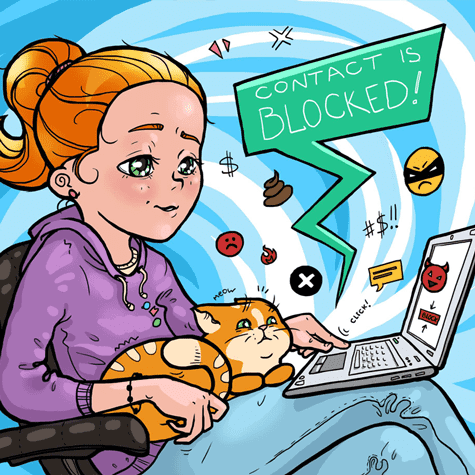
Bullying has certainly evolved from the days of after-school fistfights or shakedowns for lunch money. In fact, it has kept up with the times and made the move to emails, texting and social media. And while you may have some notion of the damage caused, statistics show that this is a widespread and dangerous problem. Here’s a look at a cyberbullying by the numbers and the top 10 ways to shut down online attackers.
1). Tell Someone
According to DoSomething.org, only one in 10 victims tells a trusted adult about online bullying—and yet 68% of teens agree that cyberbullying is a serious problem. Often, this lack of communication stems from embarrassment or fear. Kids worry that telling an adult will make harassment worse once the bully finds out, or that teachers and parents won’t be able to do anything to stop the abuse. It’s critical for you to reach out if you believe your kids are being bullied online. Look for practical ways to address the issue, such as involving school administrators or contacting social media sites directly.
2). Keep Everything
In some cases, bullying crosses the line from aggravation to criminal harassment or threats. That’s what happened to Izzy Dix, who in September 2013 committed suicide after continual online harassment. Although the police launched an investigation into the incident, law enforcement found no grounds to charge online “trolls” in Izzy’s death. Her mother, Gabbi, has now obtained records showing a pattern of social media bullying and wants the case reopened. If your child is the victim of cyberbullying, make sure to save all posts and messages from the bully by taking screenshots, or photos on your smartphone, in addition to recording the time and date.

3). Don’t Engage
Nobullying.com reports that 55% of all teens who use social media have witnessed some form of bullying, and that 95% have ignored the behavior altogether. In order to combat this, a mix of acknowledgment and avoidance is recommended. Those observing the attacks must be willing to report problems to friends, family members or teachers, while those being bullied are often better off ignoring the attacks rather than responding. The goal of any bully is to goad his or her victim into anger, in effect “getting to” the target and making him or her acknowledge ridiculous claims or malicious statements. The best option is to block the bully from social media and email accounts altogether.
4). Learn More
According to InternetSafety101.org, just 7% of parents are concerned about cyberbullying, despite the fact that 33% of teens have been victimized.
Tweet: just 7% of parents are concerned about cyberbullying, despite the fact that 33% of teens have been victimized. Tweet This!
It’s crucial as parents to learn everything you can about what your children are doing on the Internet and with their smartphones. In fact, one misconception is that boys are always the aggressors with and girls, the likely victims. However, girls are just as likely as boys to be both victims and bullies. While boys are more likely to threaten, girls focus on emotional abuse designed to undermine victims’ self-esteem, which can be more damaging.
5). Understand the Scope
Many adults believe social media sites are the likely stages for the bullying behaviors, and they’re right. But, with 73% of teens now using smartphones, there’s a greater scope of potential harm. Bullying can occur on Facebook, Twitter and Instagram, or through Snapchat, emails and texts coming directly from bullies. And since these phones never far from teen hands, the harassment can become almost constant. With technology changing so rapidly, it’s important to always monitor your children’s mobile devices and their online behavior to get ahead of any potential threats.
6). Recognize the Signs
A cyberbullied child looks the same as any adolescent—often unwilling to talk about his or her day or disclose personal information. But according to the National Crime Prevention Council (NCPC), you should look for other signs, like a loss of interest in favorite activities, skipped classes, and changes in sleeping or eating habits. While any of these may be indicative of multiple concerns, you might also notice a sudden lack of interest in using the computer—or in the case of a child who is the aggressor, extreme anger if you take his or her phone or computer privileges away.
7). Keep Data Secure
In the case of Izzy Dix, bullies were able to set up a fake Facebook profile using a stolen photograph to post harmful messages. It’s important for you and your teen to be diligent when it comes to posting data online. It’s a good idea to limit the number of personal photos and information your teen posts online. Make sure they know to always keep passwords secure and change them regularly. Bullies have been known to “hijack” victims’ profiles to post rude and offensive comments. Likewise, teens should always set social media profiles to “private” and ignore messages from people they don’t know altogether.
8). Don’t Get Turned Around
As noted by Nobullying.com, some victims do fight back against bullies, and then become bullies themselves. While this may seem like one way to solve the problem, what often happens is a “sort of back-and-forth between victim and aggressor which tends to continue the behavior.” Make sure to educate your teen about being respectful of others’ feelings and privacy online. Tell your child that you understand the impulse to retaliate, but that in the long-term it’s best to not get involved in that way.
9). Stand Together
It’s important to stand together and look for long-term solutions to cyberbullying. In Canada, a recent bill was introduced that makes it illegal to distribute images of a person without their consent, and allows police to obtain a warrant for information about Internet users based on “reasonable grounds to suspect” an offense has been perpetrated. The bill isn’t perfect, but it could become a road map for future legislation keeping your kids safe on the Internet. Meanwhile, in the US, laws vary by state, so it’s important to understand your rights and escalate things to the proper authorities if they become out of hand.
10). Hold Bullies Accountable
A team of researchers at Clemson University is developing an app that scans photos, videos and social media data to recognize signs of bullying. If bullying is detected, the app alerts the victim, their parents, school administrators and even the perpetrator, in effect providing total visibility to stop bullying in its tracks. Even without an app ready to go, parents should be holding bullies accountable by alerting school officials and the bullies’ parents. Bullies need to understand that their actions have consequences, and everyone deserves to live without fear.
Cyberbullying statistics make it clear: This is a persistent, serious problem. Armed with data and actionable solutions, however, parents and teens can help turn the tide against bad online behavior.
Other helpful reads and links related to Mobile Device Security Threats


